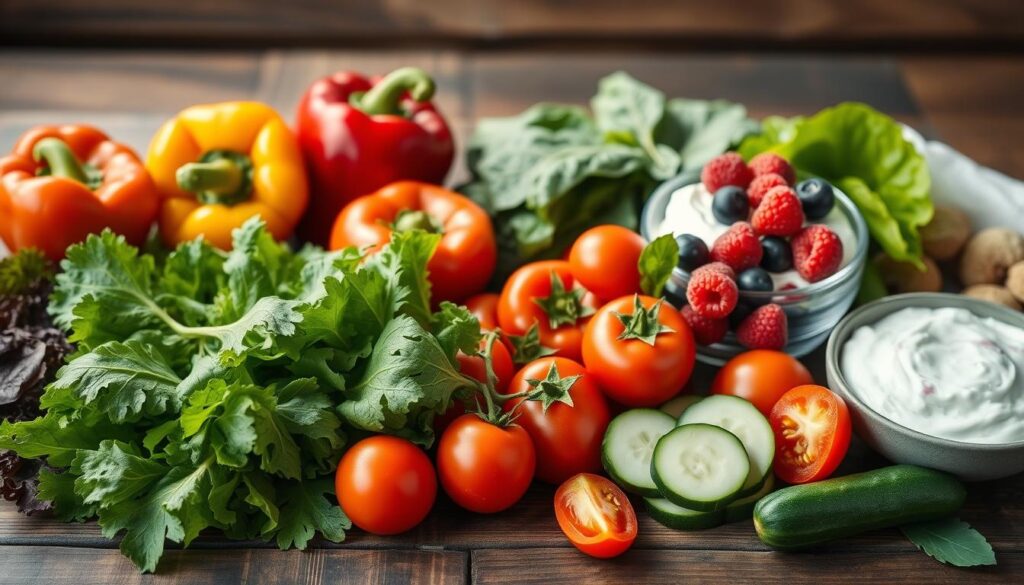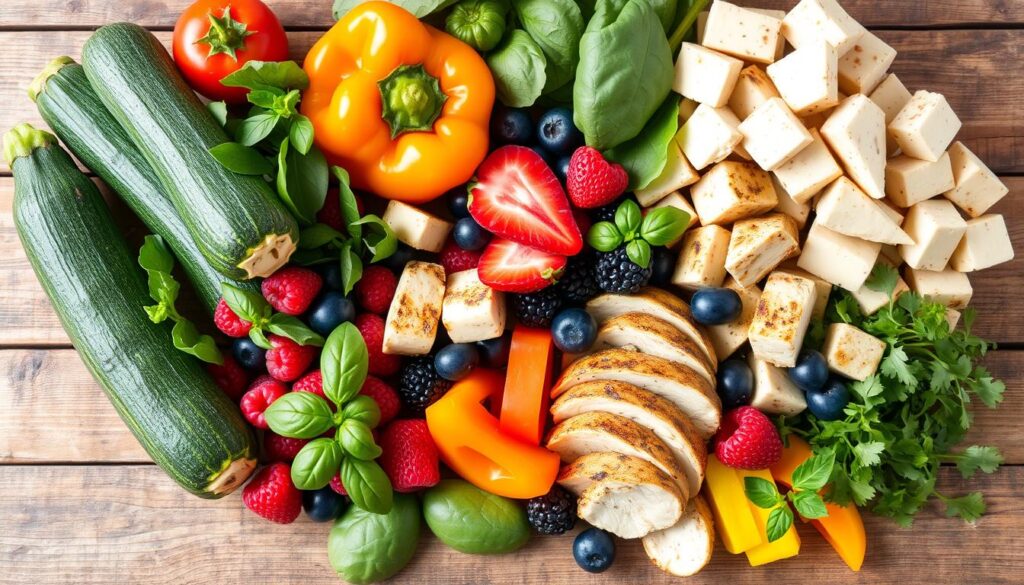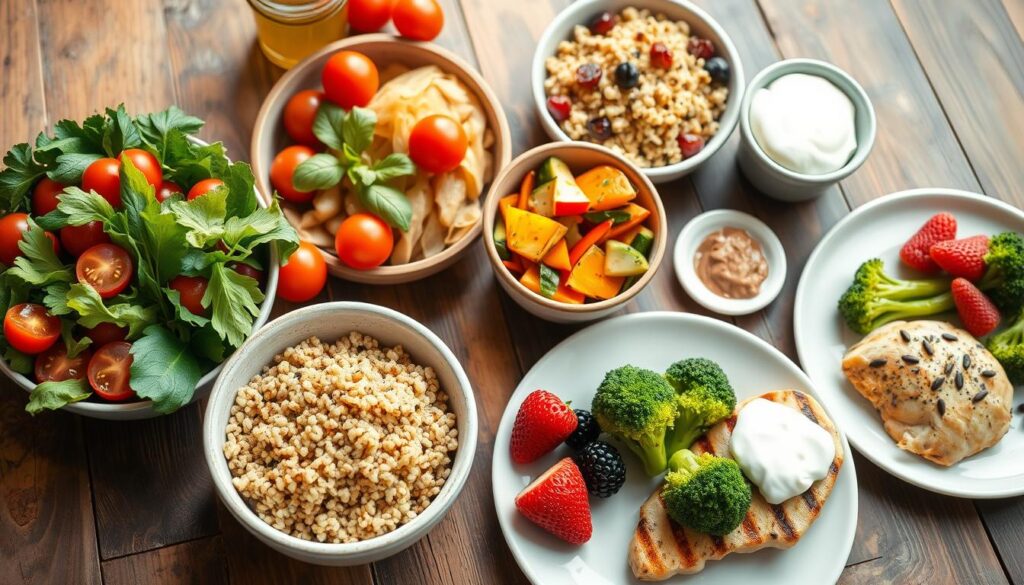As a busy professional, keeping a low-calorie options diet can be tough. Quick, high-calorie meals often seem more appealing. But, what if you could enjoy tasty, healthy meals without losing weight? Welcome to the world of delicious low-calorie options that will change how you eat.
In this guide, you’ll find many tasty, low-calorie options. You’ll learn that low-calorie eating doesn’t mean missing out on flavor. Try the zesty Chicken Banh Mi Smash Tacos, creamy Mushroom Lover’s Soup, or light Roasted Shrimp Scampi. These meals satisfy your cravings while keeping calories low.
Choosing low-calorie options is more than just losing weight. It’s about feeding your body well. These dishes make you feel full and energized. So, let’s explore the delicious, low-calorie options world that makes healthy eating easy.
Key Takeaways
- Discover a variety of flavorful, low-calorie options that satisfy your cravings.
- Understand the benefits of choosing low-calorie options for your overall health and well-being.
- Learn about nutrient-dense, low-calorie options ingredients that can be incorporated into your meals.
- Explore creative ways to prepare low-calorie options dishes that are both delicious and satisfying.
- Gain practical tips for meal planning, grocery shopping, and making smart choices when dining out.
Understanding Low-Calorie Options
Starting a healthier lifestyle often means making better food choices. low-calorie options foods give you important nutrients without adding extra weight. This way, you can enjoy light fare, calorie-conscious dishes, and nutrition-packed plates that help you reach your health goals.
What Constitutes Low-Calorie Foods?
low-calorie options foods are full of fiber and vitamins. For example, a cup of spinach has less than 7 calories. A stalk of celery has about 6 calories. Foods like oatmeal (83 calories per 1/2 cup), Brussels sprouts (70 calories per cup), and cottage cheese (163 calories per cup) are great for your meals. They help keep your calorie count low.
Benefits of Choosing Low-Calorie Options
- Weight management: Eating 1,000 to 1,500 calories a day can help you lose weight in a healthy way.
- Reduced disease risk: Eating more nutrient-packed plates and less processed food can lower your risk of heart disease and type 2 diabetes.
- Improved overall health: Eating low-calorie options, whole foods gives your body the nutrients it needs to stay healthy.
Adding these light fare and calorie-conscious dishes to your daily meals can make you feel full and happy. It helps you reach your health and fitness goals.
“Choosing low-calorie, nutrient-dense foods is a key step in maintaining a balanced, sustainable diet.”
By watching your calorie intake and choosing nutrition-packed plates, you can enjoy many benefits. These include better weight management and overall health.
Popular Low-Calorie Ingredients
Creating tasty and slimming menu items is all about the right ingredients. You can use fruits and veggies that are full of nutrients but low-calorie options. Adding lean proteins makes your meals not only healthy but also very satisfying.
Fruits and Vegetables to Consider
Berries, watermelon, and leafy greens are great for slimming menu items. They’re full of vitamins, minerals, and antioxidants. Plus, they’re very low in low-calorie options. Adding them to your meals makes your dishes both healthy and delicious.
Lean Proteins That Help You Stay Full
Chicken breast, fish, and tofu are excellent for a balanced diet. These guilt-free indulgences give you the amino acids your body needs. They also keep you feeling full, helping you avoid overeating and manage your weight.
| Protein Source | Protein (g) | Calories | Fat (g) |
|---|---|---|---|
| Chicken Breast | 32 | 158 | 3 |
| Turkey Breast | 30 | 147 | 2 |
| Cod | 19 | 134 | 5.8 |
| Shrimp | 22.8 | 119 | 2 |
| Eggs | 12 | 143 | 9.5 |
| Greek Yogurt | 16 | 92 | 1 |
| Cottage Cheese | 28 | 163 | 2.3 |
| Tofu | 21.8 | 181 | 11 |
| Edamame | 18 | 188 | 8 |
| Pork Loin | 26 | 143 | 3.5 |
Using these low-calorie options, nutrient-rich ingredients in your meals makes for delicious and guilt-free indulgences. They support your health and well-being.
Creative Low-Calorie Recipes
Start your day with foods that are good for your waistline. Enjoy lean and light cuisine that tastes great and helps you stay healthy. You’ll find delicious breakfasts, quick lunches, and easy dinners that are low in calories.
Breakfast Ideas: Start Your Day Right
Begin your morning with a low-calorie options options breakfast. Try Greek yogurt with berries and chia seeds for a protein boost. Or, make a warm oatmeal with almond milk, cinnamon, and honey for a tasty treat.
Lunch Options for Busy People
Looking for quick, low-calorie options lunches? We’ve got you covered. Enjoy a salad with lean protein and a zesty dressing. Or, try a vegetable soup or a sandwich on whole-grain bread with lean meats.
Quick and Easy Dinner Recipes
Don’t spend hours cooking after a long day. Our quick, low-calorie dinners are perfect. Try a sheet pan meal with fish and veggies or a protein-rich shakshuka with whole-grain toast. These recipes are ready in 15-30 minutes.
| Recipe | Calories per Serving | Preparation Time |
|---|---|---|
| Greek Chicken and Farro Salad | 380 | 25 minutes |
| No-Cook Salmon Salad Tartines | 348 | 15 minutes |
| Asparagus and Scallion Frittata | 280 | 30 minutes |
| Smoky Chicken Quinoa Soup | 488 | 30 minutes |
| Chickpea Salad Sandwiches | 472 | 20 minutes |
Discover the ease and flavor of these waistline-friendly foods. From breakfast to dinner, our recipes will nourish you and please your taste buds.
Snack Smart with Low-Calorie Choices
Snacking is a big part of our daily lives. But, it’s key to choose healthy, low-calorie options snacks to help your diet. There are many tasty and filling options that won’t ruin your healthy eating plans.
Low-Calorie Snacks to Keep You Full
Here are some great low-calorie options snacks to keep you full:
- Air-popped popcorn (100 calories for 6 cups, with 6g of fiber)
- Cottage cheese with fresh fruit (100 calories for 1/2 cup, with 14g of protein)
- Vegetable sticks with hummus (under 200 calories for 1 cup of veggies and 1/4 cup of hummus)
- Greek yogurt with berries (100 calories for 1/2 cup of yogurt and 1/2 cup of berries, with 12g of protein)
- Roasted chickpeas (100 calories for 1/4 cup, with 6g of fiber and 5g of protein)
Healthy Alternatives to Chips and Sweets
Craving something crunchy or sweet? Try these healthy options instead:
- Frozen grapes (100 calories for 3/4 cup)
- Homemade kale chips (100 calories for 1 cup)
- Sliced apples with peanut butter (100 calories for 1 medium apple and 2 tbsp of peanut butter)
- Dark chocolate and almonds (100 calories for 1 oz of dark chocolate and 10 almonds)
- Cucumber slices with tzatziki (100 calories for 1 cup of cucumber and 2 tbsp of tzatziki)
Adding these low-calorie, nutrient-rich snacks to your day can help with hunger and cravings. They support your healthy eating goals.
Cooking Techniques for Low-Calorie Meals
Creating tasty, light fare and calorie-conscious dishes depends on your cooking skills. Steaming and grilling are top choices for cutting calories without losing flavor.
Steaming vs. Frying: Which is Better?
Studies show steamed veggies keep up to 90% of their nutrients. Boiled veggies only keep about 60%.
Grilling for Reduced Caloric Intake
Grilling is great for calorie-conscious dishes because it lets fat drip off. This makes your food leaner and tastier. You can season it with herbs and spices for extra flavor.
Grilling also adds a smoky taste that boosts your dish’s flavor. This makes your meals more enjoyable and healthy.
Other good methods include roasting, baking, and sautéing with a little oil. These ways help keep nutrients and cut down calories. They let you enjoy tasty, light fare that’s good for your health.
“Cooking techniques can make all the difference in creating delicious, low-calorie meals. Steaming and grilling are two particularly effective methods for reducing caloric intake without compromising flavor.”
Meal Planning with Low-Calorie Options
Creating a weekly meal plan with healthy foods is a big step towards a better lifestyle. Use fresh produce, lean proteins, and whole grains to make tasty, slimming dishes. These foods will not only please your taste buds but also help you reach your health goals.
How to Create a Weekly Meal Plan
Begin by checking what you already have in your kitchen. This helps you use what you have and avoid wasting food. Next, choose low-calorie options that feature seasonal fruits and veggies for their freshness and value. Think about recipes that let you use leftovers, like turning last night’s chicken into tacos today.
Tips for Grocery Shopping on a Budget
When you go shopping, look for versatile, low-calorie options foods that can be used in many dishes. Choose frozen fruits and veggies for their long shelf life and lower cost. Also, try generic or store-brand items. They’re often cheaper but still high in quality.
| Recipe | Calories per Serving |
|---|---|
| Veggie Niçoise Pitas | 290 |
| Mushroom-Quinoa Burger | 265 |
| Barbecue Cutlets with Citrus Slaw | 265 |
| Chicken Salad | N/A |
| Poached Salmon with Coleslaw and Quinoa | 400 |
| Mushroom Quesadillas | N/A |
| Healthy Tuna Salad | 135 |
| Spicy Sausage Jambalaya | N/A |
| Breakfast Egg Stack | N/A |
Plan your meals ahead and shop smart to enjoy low-calorie options, tasty dishes without breaking the bank. Even small changes can lead to big improvements in your health and happiness.
Eating Out: Making Low-Calorie Choices
Dining out can be fun, but it’s hard to stay healthy. Yet, with some planning, you can enjoy good food without guilt. You can find healthy options at your favorite restaurants.
When you look at menus, choose grilled, steamed, or roasted foods over fried ones. Go for lean proteins like chicken, salmon, or shrimp. Add fresh veggies to your meal. Many restaurants now have healthy menu items that taste great.
- Olive Garden’s Herb-Grilled Salmon with Sautéed Vegetables (610 calories)
- Chili’s 6 oz. Classic Sirloin with Grilled Avocado (360 calories)
- Applebee’s Grilled Chicken Breast (550 calories)
Asking for Modifications Without Guilt
It’s okay to ask for changes to make your meal healthier. Ask for sauces and dressings on the side. Swap low-calorie options sides for steamed veggies. Restaurants usually agree to these changes, which can cut down calories a lot.
“Healthy substitutions can be made in restaurant dishes.”
By thinking ahead and making smart choices, you can enjoy tasty, low-calorie meals. It’s all about finding the right balance between enjoying food and staying healthy.
Low-Calorie Beverages You’ll Love
Staying hydrated is key, and there are many low-calorie drinks to choose from. Enjoy refreshing infused waters and tasty low-calorie smoothies. These drinks fit well with your lean and light cuisine and healthy meals plans.
Hydration with Low-Calorie Options
Try swapping sugary drinks for infused waters, unsweetened teas, or sparkling waters with a bit of fruit juice. For instance, a vodka soda has about 96 calories per serving. A glass of champagne has around 90 calories. Ranch water, a Texas favorite, has 125 calories per serving.
Light beers are also a good choice, with calories ranging from 103 to 125 per serving.
Popular Low-Calorie Smoothies and Shakes
- Blend Greek yogurt with berries, spinach, and a bit of honey for a nutritious, low-calorie smoothie.
- Try adding protein-rich ingredients like nut butters, chia seeds, and low-fat milk or plant-based milk to make filling shakes.
- Avoid adding too much sugar or high-calorie mixers, as they can raise the calorie count of your drinks.
By adding these lean and light cuisine and healthy meals drinks to your diet, you can stay hydrated and feel full without giving up on your diet goals.
“Staying hydrated with low-calorie options is a simple yet effective way to support your overall health and wellness goals.”
Understanding Portion Sizes
Keeping a diet-friendly cuisine and enjoying calorie-conscious dishes is all about portion control. The size of your portions greatly affects how many calories you eat. It’s a key factor in managing your weight.
The Importance of Portion Control
Studies show we can’t always judge the right portion size on our own. This is called the “portion size effect.” Over the last 100 years, the U.S. has seen a 20% increase in calories per person. This has led to more people being overweight or obese.
Larger portions from restaurants often go beyond what’s healthy. They can make you eat more calories than you should.
Visual Aids for Measuring Portions
- Use visual cues to guess the right portion size. For example, a serving of protein should be about the size of a deck of cards or the palm of your hand.
- A cupped handful is usually the right amount for grains like rice or pasta.
- You can eat more vegetables because they have fewer calories.
Knowing and using the right portion sizes can help you eat fewer calories. This supports your diet-friendly cuisine and calorie-conscious dishes goals.
“Portion control is key to maintaining a healthy diet. Paying attention to serving sizes can make a big difference in your calorie intake and weight management efforts.”
Staying Motivated on Your Low-Calorie Journey
Starting a low-calorie diet can be both rewarding and tough. To keep going and succeed, it’s key to set goals you can reach and track your progress well.
Setting Realistic Goals for Your Diet
Begin with goals you can really achieve. Aim to lose 1-2 pounds a week. This pace can help you lose 5-10% of your weight in 6 months. Try adding a new low-calorie recipe each week to build better eating habits.
Studies show that making a personal promise, like signing a contract, helps with weight loss. It keeps you on track and focused.
Tracking Your Progress Effectively
- Keep a food diary or use a smartphone app to monitor your calorie intake and nutritional balance.
- Self-monitoring through tracking your food intake increases the likelihood of successful weight loss and maintenance.
- Celebrate small victories, such as incorporating more fruits and vegetables into your meals or hitting your weekly exercise goals.
- Adjust your goals as needed to maintain motivation and ensure long-term success in your healthy eating habits.
Having support from family and friends, or a weight-loss buddy, can help a lot. Be gentle with yourself and don’t aim for perfection. Forgiveness and self-compassion are key to staying motivated.
By setting realistic goals and tracking your progress, you can stay motivated. This will help you succeed in your low-calorie journey towards healthier meals and nutrition-packed plates.
“Motivation is crap. Motivation is easy, and it’s fleeting. Motivation is a helper. Motivation can’t carry you forever.” – James Clear, author of “Atomic Habits”
Resources for Finding Low-Calorie Options
Exploring tasty and healthy low-calorie foods can really help you reach your health goals. Luckily, there are many apps, websites, and cookbooks out there. They offer great resources to find slimming menu items and waistline-friendly foods.
Apps and Websites for Healthy Recipes
Apps like MyFitnessPal, Lose It!, and Epicurious are full of low-calorie recipe ideas. They also give you nutrition info to help plan your meals. These digital tools let you find lots of tasty, healthy dishes that fit your diet and weight goals.
Cookbooks Focused on Low-Calorie Cooking
Printed cookbooks are also great for finding low-calorie cooking ideas. Books like “The Skinnytaste Cookbook” and “The Complete Mediterranean Cookbook” have healthy, tasty meals. They focus on portion control and keeping calories in check. These cookbooks can help you discover new, healthy recipes that make eating well fun and easy.
FAQ
What constitutes low-calorie foods?
Low-calorie foods are full of nutrients and fiber. Examples include oats, Greek yogurt, and berries. They offer essential nutrients without many calories.
What are the benefits of choosing low-calorie options?
Choosing low-calorie foods helps manage weight and lowers disease risk. They make you feel full and support your health goals.
What are some popular low-calorie ingredients?
Berries, watermelon, and leafy greens are popular choices. So are lean proteins like chicken, fish, and tofu. These foods are nutritious and low in calories.
What are some creative low-calorie recipes?
Try Herby Lentil and Burrata Salad or Mason Jar Instant Noodle Soup. For breakfast, Greek yogurt with berries or oatmeal with chia seeds are great. Salads with lean proteins or vegetable-packed soups make good lunches. For dinner, sheet pan meals with fish and veggies or shakshuka are quick and tasty.
What are some smart low-calorie snacks?
Air-popped popcorn, cottage cheese with fruit, and veggie sticks with hummus are good snacks. Roasted chickpeas, frozen grapes, or homemade kale chips are healthier alternatives to chips and sweets.
What cooking techniques are beneficial for low-calorie meals?
Steaming keeps nutrients and doesn’t add fats, making it better than frying. Grilling lets fat drip off, reducing calories. Roasting, baking, and sautéing with little oil are also good choices.
How can I create a weekly meal plan with low-calorie options?
Include veggies, lean proteins, and whole grains in your meal plan. Use seasonal produce to save money and ensure freshness. Frozen fruits and veggies are affordable and last longer.
How can I make healthier choices when eating out?
Choose grilled, steamed, or roasted dishes instead of fried ones. Opt for meals with lots of veggies and lean proteins. Ask for modifications like dressings on the side or swapping high-calorie sides for steamed veggies.
What are some low-calorie beverage options?
Drink infused water, unsweetened tea, or sparkling water with a bit of fruit juice. For smoothies, blend Greek yogurt, berries, spinach, and a little honey for a nutritious, low-calorie drink.
How can I practice proper portion control?
Use visual aids like comparing protein portions to a deck of cards or a palm-sized serving. For grains, a cupped handful is right. Eat more veggies because they’re low in calories. Knowing and using proper portion sizes helps manage calorie intake and supports weight goals.
How can I stay motivated on my low-calorie journey?
Set achievable goals like losing 1-2 pounds a week or trying a new recipe each week. Use a food diary or app to track calories and nutrients. Celebrate small wins and adjust goals as needed to stay motivated and achieve long-term healthy eating success.
What resources are available for finding low-calorie options?
Use apps like MyFitnessPal, Lose It!, or Epicurious for recipes and nutrition info. Check out cookbooks like “The Skinnytaste Cookbook” or “The Complete Mediterranean Cookbook” for healthy meal ideas.




